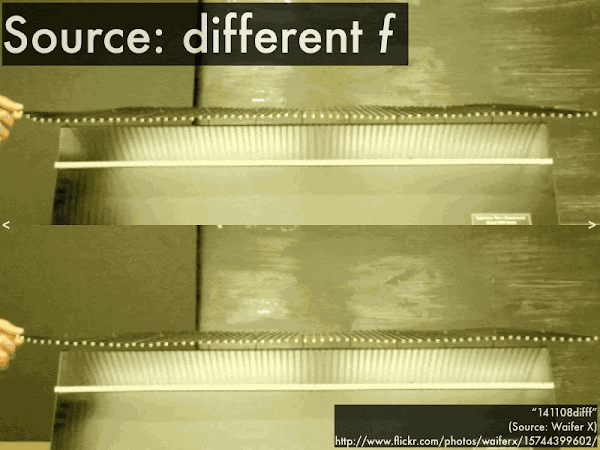Cuesta College, San Luis Obispo, CA
Students have a bi-weekly online reading assignment (hosted by SurveyMonkey.com), where they answer questions based on reading their textbook, material covered in previous lectures, opinion questions, and/or asking (anonymous) questions or making (anonymous) comments. Full credit is given for completing the online reading assignment before next week's lecture, regardless if whether their answers are correct/incorrect. Selected results/questions/comments are addressed by the instructor at the start of the following lecture.
The following questions were asked on reading textbook chapters and previewing a presentation on waves.

Selected/edited responses are given below.
Describe what you understand from the assigned textbook reading or presentation preview. Your description (2-3 sentences) should specifically demonstrate your level of understanding.
"Waves always create a disturbance and move energy from one place to another. A transverse wave has disturbance perpendicular to travel direction, and that a longitudinal wave has disturbance parallel to travel direction. The general parts of a wave, such as amplitude and period, as well as the equations that the book provided for those parts, also make sense to me."
"The motion of transverse waves is perpendicular to the direction the wave travels in. The motion of a longitudinal wave occurs parallel to its direction."
"Something I understood was waves because I learned it in chemistry. A wave can have a frequency, amplitude, wavelength, time, distance, and periods."
"As for the presentations, I am understanding what equations need to be used. I am better understanding the pendulum problems versus the oscillating springs. However I am having issues with my internet tonight so I can't see any of the GIFs so I am having a hard time with the waves presentation."
"Wavelength is the horizontal distance of a complete cycle of a wave, whereas a period is the time for one cycle to be completed. Amplitude is a measurement of distance between the highest or lowest point of a wave and the undisturbed position. Frequency is equal to one cycle per second, where the seconds represent the period. Since properties of the material/medium in which the wave travels determines the speed of a wave, we can find the speed by taking the square root of the force of tension divided by the mass per unit length."
"There are four different aspects of a wave; wave length, amplitude, frequency, and speed. Wavelength is the length that a wave stretches over itself. Amplitude is the height of a wave. Frequency is the amount of waves present or produced. Speed is the rate at which the waves move."
Describe what you found confusing from the assigned textbook reading or presentation preview. Your description (2-3 sentences) should specifically identify the concept(s) that you do not understand.
"I'm having trouble understanding the independent and dependent parameters in these equations."
"I do not understand the differences between the longitudal, periodic, transverse waves based on the pictures. The equations are also not making sense, mainly because there are so many variables to consider."
"Something that I found confusing was differentiating a period from a wavelength. The book did not do a great job at explaining the stuff."
"I think the most confusing is all these different symbols for each thing we learn. They are getting all jumbled up and it's annoying since I can't focus on what is actually what."
"Maybe it was because I had no available friends at the time of viewing these slides, but the example of the wavelengths being affected by either amplitude or frequency reached an amplitude above my head. Seemingly, the speed and wavelength are unaffected by the amplitude; however, frequency has some affect on those that I am confused about."
"I'm a little confused on how frequency and speed are independent but the wavelength is dependent on frequency and speed."
"From the presentation preview I was confused on the independent and dependent parameters at the beginning but then understood it once reading the what each symbol meant."
A string of a given length has a certain linear mass density (mass/length) value. If this string is cut in half, then its linear mass density will:
decrease. ************ [12] remain constant. ************** [14] increase. ************ [13] (Unsure/lost/guessing/help!) * [1]

(Only correct responses shown.)
Faster wave speed v: there is (approximately) a tie. [73%]
Longer wavelength λ: there is (approximately) a tie. [55%]

(Only correct responses shown.)
Faster wave speed v: there is (approximately) a tie. 38[%]
Longer wavelength λ: top wave (low frequency f). [75%]

(Only correct responses shown.)
Faster wave speed v: Along the right apparatus. [18%]
Longer wavelength λ: along the right apparatus. [88%]
Higher frequency f: there is (approximately) a tie. [18%]
For transverse waves on a string, classify each of these parameters are being "independent" (able to be changed without affecting other independent parameters), or "dependent" (will be changed when independent values are changed).
(Only correct responses shown.)
Amplitude A: independent. [65%]
Wave speed v: independent. [55%]
Frequency f: independent. [45%]
Wavelength λ: dependent. [65%]
Ask the instructor an anonymous question, or make a comment. Selected questions/comments may be discussed in class.
"How does Newton's second law cause a wall with a string attached to it to pull on the string in the opposite direction of its standing wave in order to make it reflect back the way it came?" (That sounds like Newton's third law to me.)
"I don't really understand the independent and dependent parameters of transverse waves, some review on that would be great."
"I think I just need a brief review of the independent and dependent parameters to verify I am understanding correctly."
"What is the difference between wavelength and period? Also, what are the equations that we will be using?"
"I really like this part of physics."
"Just need to hear you explain this."
"I am still confused about how to apply resonance." (We'll have a lab specifically on that later.)
No comments:
Post a Comment